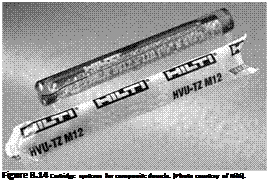The most common version of the capsule anchor consists of a cylindrical glass capsule containing a polymer resin, an accelerator and a mineral aggregate. The capsule is
|
|||
|
|
||
|
|||
|

Figure 8.13 Classification of composite dowels.
(According to Comite Euro-International du Beton CEB, 1994).
inserted into a drilled hole; deeper embedments are typically achieved by stacking multiple capsules in the hole. Setting of the anchor is accomplished by direct boring through the capsule with a threaded anchor rod (usually equipped with a chiseled end) chucked directly into a rotary drill. Straight reinforcing bars may be installed in the same way. The drilling and hammering action of the drill mixes the contents of the capsule with the fractured fragments of the capsule to form a relatively fast-setting polymer/glass matrix (Figure 8.14) [17]. As well as stiffening the polymer matrix and reducing shrinkage, the fractured glass and aggregate components serve to improve bond by scouring the sides of the hole during installation.

As an alternative to glass capsules, foil capsules have recently been developed; these are better suited for use on construction sites as they are more robust. Because oftheir flexibility they adapt themselves to the hole geometry and can easily be installed overhead. In injection anchor systems, plastic cartridges containing
|
Figure 8.15 A composite dowel. |
premeasured amounts of resin and hardener allow controlled mixing of polymer components. The components are typically mixed through a special mixing nozzle as they are dispensed, or are completely mixed within the cartridge immediately before injection. Typically, the catalyzed resin is injected into the hole first and the anchor rod (straight or deformed bar or threaded rod) is pushed into the hole and rotated slightly to promote complete contact between rod and adhesive (Figure 8.15). Care must be taken to prevent the formation of air bubbles in the adhesive during insertion of the rod. Other systems utilize a plastic pouch to contain the polymer components, which are mixed by manual kneading of the pouch. Immediately after mixing a small incision is made in the pouch, and the resin is poured into the hole.
Polymer components may also be purchased in bulk and mixed either manually or with a power mixer in a bucket and used immediately, or they may be pumped through a mixer and then injected into the hole. Both epoxies and polyester resins are available in bulk packaging. Care must be taken to assure correct mix design and adequate mixing of the resin components on site, and to protect personnel from exposure to fumes and direct contact with the polymer materials.
 16 ноября, 2015
16 ноября, 2015  Pokraskin
Pokraskin 
 Опубликовано в рубрике
Опубликовано в рубрике 